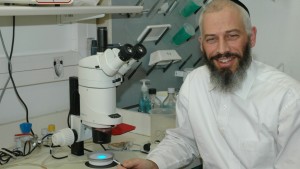Novel pathway in the development and maintenance of the ovary has implications for diagnosing and treating infertility and lack of puberty.
 The November 2015 cover story of the scientific magazine Journal of Clinical Investigation is about an Israeli discovery expected to help doctors diagnose a disease causing infertility and lack of puberty in women.
The November 2015 cover story of the scientific magazine Journal of Clinical Investigation is about an Israeli discovery expected to help doctors diagnose a disease causing infertility and lack of puberty in women.
It all started with four female cousins from a consanguineous Arab family, each suffering from ovarian dysgenesis, the failure to develop functioning ovaries. All were found to possess two X chromosomes, as do normal women, but they had no sex hormones. When they were treated with replacement hormones, the cousins grew to a normal height and entered puberty.
Researchers from Jerusalem’s Hebrew University of Jerusalem and Shaare Zedek Medical Center mapped the cousins’ genomes to search for regions of genetic commonality among them that were not shared by their healthy relatives. The map revealed that they each had a mutation in the gene Nucleoporin 107 (Nup107).
This gene codes for a protein component of the channel that connects between the cell’s nucleus (where the DNA is situated) and its cytoplasm (the remainder of the cell’s parts).
To check if the mutation was directly linked to the lack of functioning ovaries, the researchers set up an experiment using fruit flies (Drosophila) with an induced Nup107 mutation, because the formation of egg cells is a similar process in fruit flies and humans.
Sure enough, many of the female flies in the experiment demonstrated significant impairment in ovarian development. Some of the mutant female flies did lay a small number of eggs, but most of these eggs were deformed and did not hatch.
Understanding ovarian development
These results proved, for the first time, the critical importance of the Nup107 gene in the development of the ovary and formation of egg cells. This has vast implications for women suffering from conditions similar to the cousins.
“The characterization of the Nup107 gene and discovering its function in ovarian development will provide a greater understanding of how signaling between the cytoplasm and the nucleus is uniquely involved in ovarian development,” said lead researcher Offer Gerlitz from the department of developmental biology and cancer research of the Institute for Medical Research Israel-Canada at Hebrew University.
“On a medical level, it will allow the diagnosis of both patients and carriers of the disease, as well as prenatal diagnosis and prevention of this difficult morbidity of lack of puberty and infertility,” Gerlitz continued. “Potentially, it could also lead to a method of treatment for problems of infertility and premature ovarian failure.”
Until now, little has been known about the processes involved in the development of the ovary and the egg. Only a few genes have been identified as important in ovarian development, so any findings in this area are of great importance to the fields of infertility and fertility.
The Drosophila model of ovarian dysgenesis was developed in Gerlitz’s lab using a combination of advanced genetic and molecular techniques common in Drosophila research. Gerlitz believes this system could allow for the identification of signaling pathways and new genes crucial in ovarian and oocyte development.
The four ovarian dysgenesis patients were identified, diagnosed and treated by physicians David Zangen, head of pediatric endocrinology at Hadassah Medical Center-Mount Scopus, and Ephrat Levy-Lahad, director of the Medical Genetics Institute at Shaare Zedek.
Other collaborating institutions in the study included Hadassah Medical School, Hadassah University Medical Center; Bethlehem University; and Bar-Ilan University’s medical school in the Galilee. Funding was provided by the US Agency for International Development program for Middle East Regional Cooperation; the Hassenfeld family; the Israel Science Foundation; and the Legacy Heritage Biomedical Program of the Israel Science Foundation.


